Physical Address
304 North Cardinal St.
Dorchester Center, MA 02124
The authors would like to acknowledge and thank Dr. Anthony A. Stans and Dr. Robert N. Hensinger, MD, for their contributions to the previous versions of this chapter.
Overall, vascular trauma is relatively uncommon in pediatric patients. One study reviewed all pediatric patients who presented to a level 1 trauma institution over a 6-year period and found that only 23 presented with a major arterial injury. Other studies have shown that these admissions account for less than 1% of all pediatric trauma admissions. However, 58% of neurovascular injuries in children are associated with orthopedic injuries. Typically, the artery involved is near the fracture. For example, the common femoral artery is at risk with intertrochanteric fractures of the hip and hip dislocation, and the superficial and profunda femoral arteries are at risk with subtrochanteric and midshaft fractures. The femoral artery can be injured at the adductor hiatus by a supracondylar femoral fracture. Injury to the popliteal artery or to a combination of the anterior and posterior tibial arteries is usually associated with fracture of the distal femoral ( Fig. 7.1 ) or proximal tibial epiphysis, or a knee dislocation (32%–64%). It is critical that the orthopedist have a high index of suspicion for vascular injury in pediatric trauma patients, because of the association between vascular injury and orthopedic trauma as well as the potentially devastating complications associated with delayed treatment of a vascular injury.
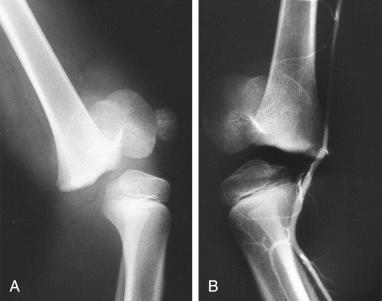
As in adults, massive bleeding and arterial hemorrhaging can occur in children with pelvic fractures. In one study, the mortality rate was 5% in children and 17% in adults. The fracture patterns are usually a combination of anterior and posterior injuries to the pelvic ring, either unilateral or bilateral. O’Neill and colleagues noted that posterior arterial bleeding (internal iliac and posterior branches) was more common in patients with unstable posterior pelvic fractures, whereas anterior arterial bleeding through the pudendal and obturator arteries was more often associated with lateral compression injuries. Injury to the superior gluteal artery was the most common injury associated with posterior pelvic fractures. Angiography to identify the arterial hemorrhage and embolization to control bleeding have been helpful. Similarly, skeletal fixation to reduce the fracture can help control bleeding in pediatric patients at high risk of life-threatening hemorrhages.
One typically associates vascular injuries with extremity or pelvic trauma. However, Tolhurst and colleagues documented an 11% incidence of cervical vascular injury in 61 patients evaluated for blunt cervical trauma. Central thoracic and abdominal vascular injuries have also been associated with blunt motor vehicle trauma.
The usual signs of vascular compromise are (1) absent distal pulses, (2) decreased skin temperature, and (3) poor skin circulation with diminished capillary and venous filling distal to the injury. In the setting of lower extremity trauma, particularly knee dislocations or severely displaced distal femoral and/or proximal tibial physeal fractures, the ankle brachial index (ABI) is a critical component of the physical examination in the trauma bay. In this setting, palpable distal pulses and an ABI of 0.9 or higher has been shown to be 100% sensitive for detecting an arterial injury. Displaced fracture and/or joint dislocations associated with suspected vascular injury should be emergently and safely reduced, either in the emergency department or in the operative theater. Angiogram or vascular ultrasound studies should be considered whenever vascular injury is suspected, especially if concerns for vascular injury persist after fracture and/or joint reduction. Absolute indications for vascular imaging are a diminished or absent pulse, a large or expanding hematoma, external bleeding, unexplained hypotension, or a bruit. Evidence of a peripheral nerve injury should also raise suspicion for an associated vascular insult. If the period of extremity ischemia approaches 6 hours, operative exploration should proceed immediately, and it may be necessary to obtain vascular imaging in the operating room.
Pulses may initially be palpable and then disappear (delayed loss of pulse). Such delayed loss is usually caused by damage to the intima with subsequent development of thrombosis. Damage to the popliteal artery from a knee dislocation is commonly limited to the intima. In children, intimal damage is often more extensive than apparent on simple inspection. Children are particularly prone to ischemia because of arterial spasm, which is less common in adults. The patient should undergo further evaluation for vascular injury if the pulse does not return after reduction of the fracture or dislocation ( Fig. 7.2 ). One study of 116 patients with knee dislocations found that 90% of those who had abnormal pulses after joint reduction had associated vascular injuries found on arteriography. Observation of a warm, pulseless leg after dislocation of the knee is insufficient. Frequently, these patients have good capillary flow because the amount of flow required to maintain viability of the skin and subcutaneous tissue is much less than that required by muscle. In these circumstances, Green and Allen reported that 90% of the limbs either eventually underwent amputation or had claudication or incapacitating muscle fibrosis and contracture.
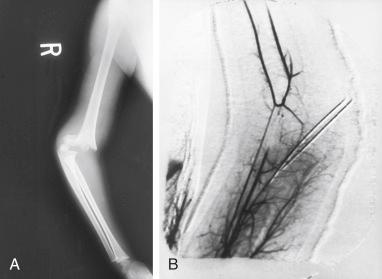
In general, the indications for limb salvage are extended in children because of their greater capacity for healing; however, no data have established the limits of salvage. Of all limbs, 90% can be salvaged if the circulation is reestablished within 6 hours, whereas revascularization after 8 hours from the time of injury can result in an amputation rate of 72% to 90%. With massive crush injuries and collateral vessel damage, the 6-hour period of warm ischemia may be too long because of the risk for associated muscle injury and rhabdomyoloysis. One must also consider the seriousness of associated polytrauma, the degree of damage to the ipsilateral foot, the time required to obtain soft tissue coverage and bone healing, and the potential for rehabilitation. The Mangled Extremity Severity Score can be helpful in determining prognosis of limb salvage in pediatric patients.
In children, autogenous vein grafts are recommended rather than synthetic or bovine material because these types of grafts have been shown to not work well over long-term follow-up in children. Spatulation of the ends of the vessels and using interrupted rather than running suture repair techniques allow for a longer suture line that will accommodate a later increase in vessel size without stricture. In contradistinction to proximal injuries, isolated single vessel injuries distal to the elbow or knee may, on occasion, be treated by vessel ligation.
Distal compartment syndromes are common after late diagnosis or repair of vascular injuries. Fasciotomy should be considered after vascular repair so that a late compartment syndrome is avoided. Patients should be monitored in the early postoperative period for myoglobinuria or a rise in creatinine or phosphokinase levels. Signs and symptoms of renal insufficiency should also be sought because both are consistent with the diagnosis of rhabdomyolysis. In the lower extremity, repair of a proximal artery may not result in saving the entire limb but may preserve the knee, which has important functional implications when considering walking speed and energy cost of ambulating with a prosthesis.
Fracture stabilization can be accomplished by a variety of means. Ideally, if time permits, reduction and fixation of the fracture should precede vascular repair. Initial bony fixation provides maximal skeletal stability and reduces further trauma to the soft tissues, nerves, and collateral blood vessels. Similarly, surgical repair of nerve lacerations is facilitated by bony stabilization. If soft tissue coverage can be achieved, internal fixation is preferred. External fixation, particularly in a severely traumatized limb, has many advantages, including a short operative time. Zehntner and colleagues found that complications were less frequent with initial external fixation of lower extremity fractures than with internal fixation. Indwelling arterial and venous shunts can be helpful in selected cases for reduction of the risk of further vessel damage and compartment syndrome. Similarly, temporary shunting can provide a satisfactory solution to the clinical problem of whether an ischemic limb should be revascularized before fracture fixation. Surgical shortening of the bone may facilitate vascular repair, and the leg length discrepancy can be resolved at a later time.
Early complications include wound infection, below-knee amputation, deep vein thrombosis, and motor and sensory deficits. Revascularization does not eliminate the possibility of abnormal growth (i.e., overgrowth and undergrowth). All children should be monitored for limb length discrepancy until limb lengths stabilize. Discrepancies that do not stabilize over time can be addressed through either a contralateral properly timed epiphysiodesis, ipsilateral limb lengthening, or a combination of the two to achieve equal limb lengths at skeletal maturity. In addition, as the child ages, the collateral circulation may not be adequate to meet the increased physiologic demands, ischemia-like symptoms may be triggered by activity, and subsequent arterial reconstruction for chronic vascular insufficiency is sometimes required.
Vascular injury is the most serious complication associated with supracondylar fractures; fortunately, it is uncommon. If the child has a pulseless extremity, the fracture should be reduced immediately in an attempt to restore blood supply and avoid compartmental ischemia (see Fig. 7.2 ). Campbell and colleagues found a brachial artery injury in 38% of patients who had severe posterior lateral displacement of their supracondylar fracture. Because children are uniquely susceptible to vasospasm, the pulse may not be restored to normal, and a Doppler waveform analysis may be helpful. Many recent technologic improvements, such as color flow duplex scanning and magnetic resonance imaging (MRI), are now available. These techniques are noninvasive and safe for evaluation of the patency of the brachial artery, but they need further study to assess their applicability in clinical practice. Children may have very good secondary capillary perfusion, which can lead to the false assumption that the vascularity is intact. The collateral circulation may be sufficient to maintain a pulse in the distal circulation but not sufficient to maintain perfusion through specific muscle groups. Sabharwal and associates recommended that if the collateral circulation across the elbow is satisfactory, revascularization is not indicated in an otherwise well-perfused hand. They concluded that revascularization of a pulseless but otherwise well-perfused limb with a type III supracondylar fracture, although technically feasible and safe, has a high rate of asymptomatic reocclusion and residual stenosis of the brachial artery. However, a recent meta-analysis was performed, reviewing the relevant observational studies concerning neurovascular injuries in supracondylar humerus fractures; it suggested that the incidence of brachial artery injuries in patients with pulseless but perfused hands is consistently underestimated by treating surgeons. The use of a basilic vein graft from the zone of injury has been shown to be an acceptable arterial conduit in patients requiring grafting.
With more frequent use of fixation for supracondylar fractures, the incidence of vascular injury seems to have decreased, thus suggesting that some of the previous vascular problems were caused by the flexed position required to maintain the reduction. If the vascular status of the limb is questionable, Doppler studies and/or vascular imaging studies should be performed promptly. Similarly, children should have frequent vascular examinations after reduction for signs of vascular insufficiency from intimal tears and brachial artery stenosis. Blakemore and colleagues found that one-third of the children who had displaced supracondylar fractures associated with an ipsilateral forearm fracture (the floating elbow) developed a compartment syndrome. Ring and colleagues found that floating elbows are associated with substantial swelling and increased potential for a compartment syndrome, particularly when they are immobilized in a circumferential cast. Other reports of pediatric patients with floating elbow injuries have described a significantly increased rate of acute neurologic injury in this population but have not demonstrated an increased risk of associated compartment syndrome when compared with isolated supracondylar humerus fractures. Loss of reduction is common, and traditionally, it has been recommended that both fractures be stabilized. However, Blumberg et al suggest that forearm fixation is not always essential in these patients, and the decision to stabilize the forearm should be made on a case-by-case basis.
Nerve injuries are associated with approximately 2.5% of extremity fractures in children and are more than twice as likely to be found with upper extremity fractures than with lower extremity fractures. Displaced supracondylar fractures are often associated with acute neurologic injury, with studies reporting an overall incidence as high as 12% to 16%. Campbell and colleagues found that posterior lateral displacement of a type III supracondylar fracture was associated with a higher incidence of median nerve injuries (52%). If the injury is closed and the reduction satisfactory, the child can be treated expectantly, and most will recover, usually in the first 2 months. One of the more subtle median nerve injuries is injury to the anterior interosseous branch from either traction or contusion. Posterior lateral fracture displacement was correlated with the median nerve and vascular compromise, whereas posteromedial fracture displacement is strongly correlated with radial nerve injuries. Medial pinning for supracondylar fractures has been known to place the ulnar nerve at risk of injury. Fortunately, simple removal of the medial pin results in complete recovery in the vast majority of patients. The American Academy of Orthopedic Surgeons Clinical Practice Guidelines for the Treatment of Pediatric Supracondylar Humerus Fractures makes a limited-strength recommendation for the use of two or three lateral pins so that potential harm caused by medial pin placement is avoided.
The ulnar nerve can be injured in the initial trauma, during reduction, or later as a result of progressive elbow deformity. The ulnar nerve is often damaged early by posterior dislocation of the elbow, particularly if associated with a medial epicondylar fracture. However, ulnar nerve damage has also been reported with condylar and supracondylar fractures, particularly flexion-type supracondylar fractures, and acute ulnar neuropraxia has been tied to an increased need for open reduction in these injuries. Tethered by the cubital tunnel, the ulnar nerve is also at risk of injury in Monteggia fracture variants involving the proximal end of the ulna and has also been reported with radial head fractures and with chronic radial head dislocations.
Both valgus and, less frequently, varus deformity that may occur after a lateral condylar fracture can lead to delayed development of ulnar neuropathy. Late ulnar nerve lesions at the elbow have been divided into three main categories based on the mechanism of injury: traction such as occurs in a valgus deformity, compression within the limited space of the cubital tunnel, and friction from bone fragments or osteophytes in close proximity to the nerve. Symptoms of ulnar nerve neuropathy include paresthesias, intrinsic muscle weakness, and wasting. An electromyogram can be helpful in establishing the diagnosis. Treatment usually consists of surgical decompression of the nerve, correction of the angular deformity of the elbow, or both. Transposition is recommended if the ulnar nerve appears normal, if the symptoms are intractable, or if a valgus deformity of the elbow is present. If the condition has been of long duration, the pain and paresthesias should resolve, but weakness and muscle wasting may persist.
Posterior interosseous nerve (PIN) injury is well associated with fractures around the elbow. Li et al described eight cases of acute PIN entrapment in the radiocapitellar joint after Monteggia fracture-dislocations. Acute PIN entrapment into the radiocapitellar joint has also been described after the repair of a Monteggia fracture with an ulnar osteotomy. Closed and open reduction of radial neck fractures are also associated with PIN injuries because of the close proximity of the nerve to the fracture site. Choi et al reported excellent results with percutaneous reduction of radial neck fractures without associated PIN palsy and recommend a stepwise approach to minimize the risk of nerve injury.
Median and ulnar nerve injuries are common in physeal and metaphyseal fractures of the distal radius. The mechanism of injury includes direct contusion from the displaced fragment, traction, and ischemia. Waters and associates recommend that if a patient has a normal vascular examination but persistent neurologic symptoms and significant soft tissue swelling, closed reduction and percutaneous pinning may be indicated so that the need for a constrictive cast is eliminated.
Because most pediatric nerve injuries resolve with expectant management after fracture treatment, an initial period of observation is recommended. If no signs of nerve recovery are present 4 months after the injury, then electromyography and nerve conduction studies are recommended. If the electromyographic and nerve conduction studies show no sign of recovery, then exploration and possible repair or grafting of the nerve should be considered. Bolitho and colleagues recommended early repair of ulnar nerve injuries in young children. Distal injuries had a better outcome than proximal ones, but satisfactory function of the intrinsic hand muscles occurred in both groups. Veldman and Goris found that repair of the transected nerve in young children (younger than 13 years) leads to good motor and sensory recovery. Amillo and Mora assessed neural injuries associated with elbow fractures in 25 children (average age at injury, 9.4 years). Eight had discontinuity of the nerve trunk, and 17 had constrictive lesions around the nerve. In those with constrictive lesions, 80% had good results after neurolysis. In those who had disruption, 66% had good results after grafting. The prognosis was poor if surgery was performed more than a year after the injury. They recommended surgical exploration and neural lysis or repair with a graft for open neural injuries. Grafts longer than 10 cm had a poor prognosis.
Under very unusual circumstances, the median and ulnar nerves can become entrapped after dislocation of the elbow. When entrapment occurs, the diagnosis is often delayed. Early signs of entrapment are the persistence of a significant median nerve deficit and pain greater than expected after reduction of the elbow dislocation. Later signs include a severe elbow flexion contracture and, radiographically, a bony depression in the distal medial humeral cortex corresponding to the location at which the median nerve travels posterior to the humerus and enters the elbow joint. The brachial artery and vein and the median nerve can also be trapped between the fracture fragments in a widely displaced supracondylar fracture. Attempts at closed reduction usually lead to vascular compromise, which necessitates open surgical reduction.
Secondary nerve injuries can result from simple positioning, particularly in children in a coma or in those with head injuries. The ulnar nerve is very susceptible to compression at the elbow, and the radial nerve is susceptible at the midportion of the humerus if the arm is not properly positioned. Patients with these neurapraxias, if recognized early, have a good chance of recovery. The peroneal nerve may be compressed as it passes over the neck of the fibula. Frequent examination of the extremity for neurovascular status is essential, particularly in the immediate postinjury and early recovery periods or until the child is alert enough to report any changes. Obviously, in children with head injuries, casts should be well padded over these susceptible areas.
Pediatric acute compartment syndromes (PACS) can occur in a multiply injured child with the same frequency as in an adult. The condition is caused by swelling and increased pressure in a closed space, such as a fascial compartment, but it can also occur from tight skin or a circumferential cast. If not treated promptly, it leads to tissue ischemia, myonecrosis and contractures ( Fig. 7.3 ). The most common anatomic locations for PACS include the leg, forearm, hand, foot, and thigh.
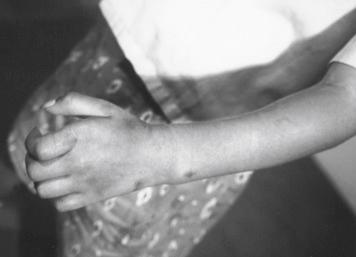
The causes of PACS have evolved with time. Initially, fractures of the forearm and femur were associated with the greatest rates of compartment syndrome. As fracture management has evolved, more recent evidence has shown that most common long bone fracture associated with PACS is the tibia. Although tibia fractures account for only 15% of all pediatric long bone fractures, they are associated with 40% of all acute compartment syndrome cases in children. PACS may occur after simple Salter-Harris type I or II fracture of the distal end of the radius or proximal part of the tibia and in both open and closed injuries. A common misconception is that an open injury will decompress the compartment. However, not all compartments are successfully relieved by an open injury. Regardless of fracture location, studies have shown that patients who require longer operative times and more intraoperative fluoroscopy are at greater risk of developing compartment syndrome, which likely reflects the difficulty of the reductions and more manipulation of the fractures intraoperatively.
Children with femoral shaft fractures treated by skin traction or early spica cast use have been shown to be at risk for PACS of the thigh and leg. When placing a child in a 90/90 spica cast, applying the body and thigh portion of the spica cast before placing the short leg component and minimizing traction through the leg while applying the cast can reduce this risk.
Early operative stabilization of fractures does not eliminate the risk of compartment syndrome. Femoral fractures that are treated with closed intramedullary fixation are also susceptible to compartment ischemia. In restoring femoral length, the muscles are pulled to length, and the integrity of the compartments is restored; however, a compartment syndrome can occur. As flexible intramedullary nailing of forearm and tibia fractures has become more popular, a corresponding rise has been seen in the number of patients experiencing PACS with this technique. PACS of the foot are most commonly associated with a Lisfranc fracture-dislocation but have also been reported with fractures of the metatarsals and phalanges. They may also occur in the setting of a crush injury, even in the absence of a fracture.
In addition to fractures, PACS are associated with severe contusion, crush injuries, vascular injury resulting in prolonged tissue ischemia, prolonged limb compression, burns, and vigorous exercise. Multiple traumatic injuries predispose a child to PACS because of additional high-risk factors such as hypotension, vascular injury, and high-energy blunt trauma, which increase tissue necrosis. PACS in the thigh have been reported in teenagers after blunt trauma and because of systemic hypertension, external compression with antishock trousers, and vascular injury with or without fracture of the femur. Nonfracture-related episodes of PACS have been shown to have longer time to diagnosis and worse outcomes compared with fracture-related compartment syndrome cases, emphasizing the importance of early recognition and treatment of this condition.
Children may be at increased risk for compartment syndrome compared with adults because of (1) predisposition to vasospasm, (2) smaller vessel diameter, (3) greater resting compartment pressures, and (4) atypical presentation compared with adults.
As the pressure increases within the space, one of the early findings or complaints in adults may be a decrease in sensation, or paresthesia. Pain, swelling, and tenseness of the compartment are found on physical examination. These symptoms may be difficult to recognize in children who are too young to cooperate with the examination or in those who have a head injury. Bae and colleagues found that pain, pallor, paresthesia, paralysis, and pulselessness were relatively unreliable signs and symptoms. An increasing analgesia requirement in combination with clinical symptoms was a more sensitive indicator. All 10 of their patients who had access to patient-controlled or nurse-administered analgesia had an increasing requirement for pain medication that preceded other clinical signs or symptoms by an average of 7 hours. Noonan and McCarthy have stressed the importance of recognizing the three A s of pediatric compartment syndrome—agitation, anxiety, and increasing analgesic requirement—which often precede the classic presentation by several hours. Pulse oximetry is not helpful in the diagnosis of compartment syndrome because a normal reading does not imply adequate tissue perfusion.
With continued ischemia, voluntary use of the muscles is decreased, and eventually complete paralysis ensues. Pain on stretching the involved muscles is a common finding but is subjective and may be the result of trauma. Early ischemia of the nerve may cause anesthesia and obscure this very sensitive finding. An excellent example of this diagnostic dilemma is the loss of toe dorsiflexion after a metaphyseal fracture of the proximal end of the tibia, which may be caused by a direct injury to the peroneal nerve or anterior tibial artery or by an anterior compartment syndrome.
Compartment pressures are seldom high enough to occlude a major artery, so the peripheral pulses are often palpable, and capillary filling is routinely demonstrated in the skin of the hand or foot. With a tissue pressure exceeding 30 mm Hg, capillary pressure is not sufficient to maintain blood flow to the muscles, and necrosis results. With severe intercompartmental edema, the nerves show a gradual decline in action potential amplitude. A complete conduction block can be obtained with a pressure as low as 50 mm Hg and after 6 to 8 hours of sustained pressure of 30 or 40 mm Hg.
Diagnosis or exclusion of compartment syndrome on clinical grounds alone may be impossible. The most objective method of making the diagnosis is by measuring compartment pressure. Because of the invasive nature of the test, this is not used as routinely in children as in adults. Nonetheless, it is mandatory that anyone who is managing trauma in children be able to determine these values. Generally, a pressure greater than 30 mm Hg is considered abnormal, as muscle damage has been shown to be significant when intercompartmental pressures are greater than 30 mm Hg for a period of 6 to 8 hours.
Although some authors have promoted using pressure readings greater than 30 mm Hg as an absolute threshold for diagnosis of compartment syndrome, there is data to suggest that this value may not always be appropriate. The tissue ischemia caused by PACS is a result of an imbalance between arterial inflow and venous outflow from a myofascial compartment. The patient’s mean arterial (MAP) and diastolic blood pressures need to be considered in establishing the diagnosis. In a clinical situation in which a myofascial compartment pressure is less than 30 mm Hg but still within either 30 mm Hg of the MAP or 20 mm Hg of the diastolic blood pressure, there may be an imbalance of arterial inflow and venous outflow within the compartment. This results in vascular congestion, edema, and, ultimately, tissue necrosis. Children have also been shown to have higher resting compartment pressures than adults. In combination with a pediatric patient’s lower resting blood pressure, the higher resting compartment pressures may predispose children to developing PACS compared with adult patients.
Battaglia and associates measured compartment pressure in children with supracondylar fractures before and after reduction. They found that pressure is greatest in the deep volar compartment and closest to the fracture site. Fracture reduction did not have a consistent or immediate effect on reducing pressure. They recommended that the elbow not be flexed beyond 90 degrees, which was associated with significant (the greatest) pressure elevation. If a fasciotomy is necessary, one must adequately decompress the deep volar musculature. None of their patients exhibited signs and symptoms of compartment syndrome, which suggests that absolute pressure thresholds, no matter how great, are inadequate as indicators of impending compartment syndrome, and they support the concept that the absence of clinical indications alone is insufficient as an indication for fasciotomy.
Initial treatment should include splitting a tight cast and removal of occlusive dressing material and cast padding, all of which will decrease compartment pressure. Univalving the cast and adding spacers of 3 mm to 12 mm in width have been shown to decrease pressure in a cast by as much as 50% to 80%. Elevation of the limb may increase compartment pressure and may be counterproductive if coupled with a decrease in perfusion; this combination may be the mechanism by which ischemic contractures occur after femoral fractures in children. Placing the limb at approximately the same level as the heart may be optimal.
Compartment syndrome does not seem to affect healing of the fracture, and nonunion or delayed union is seldom associated with it. However, the healing time for closed fractures associated with compartment syndrome was noted by Turen and associates to be longer, 30.2 versus 17.3 weeks. Interestingly, compartment syndrome lengthens the time for healing of closed fractures, but the healing time was approximately the same as for an open fracture. The method of fixation does not affect the healing time.
The duration of the compartment syndrome before definitive surgical decompression is the most important factor in determining functional outcome. If decompression is accomplished during the early swelling phase of compartment syndrome, most patients will have normal function. In the upper extremity, Ziolkowski et al demonstrated that increased time to surgical decompression in PACS resulted both in increased risk of significant functional deficit and need for reconstructive surgery, including flap reconstruction. Livingston et al also found that delayed diagnosis of PACS resulted in a high incidence of myonecrosis noted during surgery and a significant impairment of function postoperatively, with only 56% of patients returning to full function by final follow-up. More than 44% of patients in this study had persistent pain, contractures, limited motor function, and/or paresthesias postoperatively at final follow-up. Late surgical decompression exposes devitalized muscles, which require débridement, and, in some instances, infection can ensue and necessitate multiple débridement procedures and antibiotics. When diagnosis of an upper extremity PACS is delayed, Chuang and colleagues recommended exploration and excision of the infarcted muscle within 3 weeks of injury. They found that such a time frame preserves intrinsic hand function and sensation by removing the ischemic environment and preventing the fibrosis that may add to nerve compression and damage.
Neonatal compartment syndrome is a distinct form of PACs. It is uncommon, and reported causes include disseminated intravascular coagulation and spontaneous arterial thrombosis. Neonatal PACS is associated with significant swelling of the limb, and sentinel skin lesions and blisters have been reported. Although it is not strictly associated with skeletal trauma, the orthopedist must be familiar with this condition, as early diagnosis and immediate full fasciotomy of the affected extremity is critical for preserving tissue and function of the limb. Immediate recognition can be the difference between limb preservation or amputation and reconstructive surgery in this population.
The most common malunion experienced by children occurs after a supracondylar fracture of the humerus, usually resulting in a cubitus varus deformity ( Fig. 7.4 ). In the past, the deformity was attributed to a disturbance in elbow growth. However, clinical and experimental evidence indicate that the more common cause is an initial unsatisfactory reduction or early loss of reduction. Unfortunately, the cross section of the proximal humeral fragment is narrow, and unless the distal fragment is reduced anatomically, it is easy for this fragment to rotate and tilt medially, causing subsequent cubitus varus deformity and limitation of elbow flexion. Growth at the distal end of the humerus contributes only 10% of the length of the upper extremity, and as a consequence, the potential for subsequent remodeling is limited. The recent popularity of closed reduction with exact anatomic alignment maintained by pin fixation has lessened the frequency of this complication.
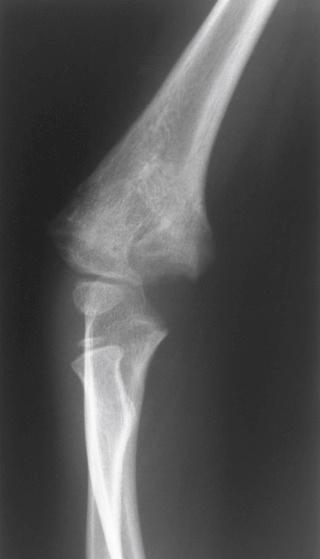
Most children do not have a functional deficit but may have a significant cosmetic deformity. If the deformity is present after 1 year and is posing problems, it may be managed by corrective osteotomy. Several authors have described a variety of ways to achieve angular correction. It is not necessary to correct all the deformity of the supracondylar region. Correction of the rotation, however, is much more difficult though the shoulder usually adequately compensates for it. Most authors prefer a lateral closing wedge to correct only the angular alignment and are not concerned about the rotation or flexion-extension aspects of the deformity. Barrett and associates, in their review of this procedure, found that patients were generally pleased with this approach. Fixation of the osteotomy is a problem because of the small size and peculiar shape of the distal end of the humerus, which does not lend itself to standard fixation methods. Blasier recommended a triceps-splitting approach to the supracondylar region that provides excellent visualization and facilitates the osteotomy. Pin fixation can be done under direct visualization with greater ease than with a lateral approach. Herzenberg et al have reported successful reconstruction of cubitus varus using gradual correction with external fixation. The advantage of a gradual correction with a hexapod frame is that it minimizes risk of acute vascular and neurologic injury during correction and, by reassessing the osseous alignment and adjusting the hexapod “prescription” during treatment, the surgeon is able to precisely correct all aspects of the deformity.
Unrecognized angular malunion of the ulna in Monteggia injuries can lead to persistent subluxation or dislocation of the radial head and significant loss of pronation and supination. A Monteggia lesion consists of a fracture of the ulna and dislocation of the ipsilateral radial head. This lesion can be subtle; in a small child, it may be difficult to assess the relationship of the radial head to the capitellum, and associated deformation of the ulna may be subtle. As a consequence, an acute lesion is often misdiagnosed ( Fig. 7.5 ). Similarly, displacement or angulation of the ulna and subluxation of the radial head may occur in the weeks after reduction (approximately 20%), especially when the ulnar fracture is oblique. A recent multicenter study reported a 19% rate of loss of reduction in Monteggia fractures treated nonoperatively. In this study, all patients who had recurrent radial head dislocations presented with Monteggia fractures with a complete ulna fracture. These authors recommended that patients with Monteggia fractures who have complete fractures of the ulna be treated surgically in light of the high risk of loss of reduction with nonoperative treatment.
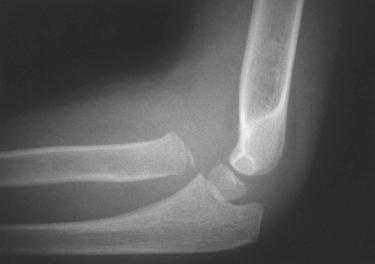
Rodgers and associates published a review of complications and results of reconstruction of Monteggia lesions in children. Attempts at late repair of this lesion were met with considerable problems, including decreased rotation of the forearm, transient motor and sensory ulnar nerve palsies, and residual weakness. However, they believe that the long-term sequelae (pain and weakness) of chronic Monteggia lesions warrant intervention in a skeletally immature patient. If malunion of the ulna prevents reduction, an osteotomy should be performed, preferably one rigidly fixed with a plate ( Fig. 7.6 ). Steinmann pins can be placed antegrade down the ulnar. Inoue and Shionoya recommend overcorrecting the ulna using plate fixation, particularly in situations in which the radial head reduction is unstable. Unrecognized, the deformity of the head caused by growth in a dislocated position makes restoration of the normal radial-ulnar-capitellar relationship difficult. If the radial head is not stable, a temporary pin can be placed to transfix the radiocapitellar joint. If the annular ligament is incompetent, it can be replaced or reconstructed with the use of a strip of triceps fascia as described by Bell Tawse in the article by Rodgers and colleagues.
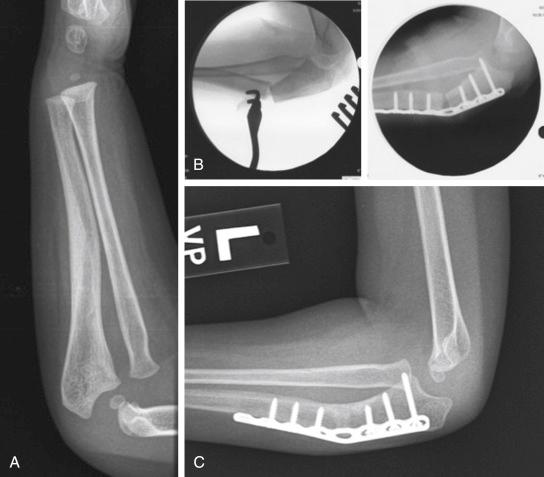
Fractures of the forearm in children are a common cause of malunion because the reduction can easily be lost and can be difficult to regain ( Fig. 7.7 ). Young children can occasionally remodel the fracture dramatically; as a consequence, physicians have a tendency to depend heavily on remodeling and accept a less than adequate reduction. Midshaft fractures are particularly at risk of deformity. Price and colleagues recommend acceptance of up to 10 degrees of angulation, 45 degrees of malrotation, and complete displacement before attempting remanipulation or resorting to open reduction and internal fixation.
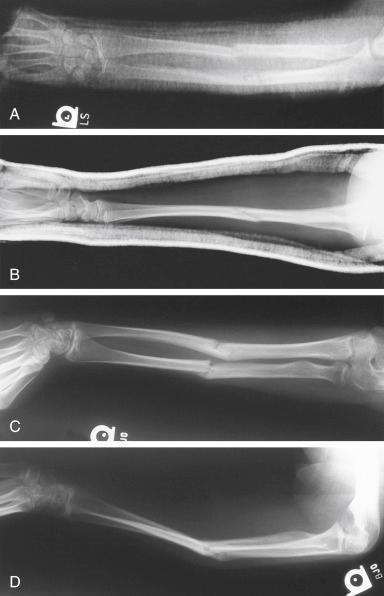
Nietosvaara and colleagues found that 48% of distal radial fractures healed in malunion, despite anatomic primary reduction in 85% of the cases. The displacement correlated with marked initial malposition of the fracture (>50% displacement or 20% angulation). An independent risk factor for complications and redisplacement was a nonanatomic reduction of the fracture. In some cases, redisplacement in the cast did not occur until 2 weeks after the injury. They suggested pin fixation should be considered if there is an associated injury, compartment syndrome, or a second fracture in the same extremity (floating elbow), and in children with less than 1 year of growth remaining.
The degree of angular deformity that is acceptable during fracture treatment depends on fracture location and patient age. Remodeling of an angular deformity is better in the distal third of the radius and ulna than in the midshaft or proximal third and is better in younger children. A study by Crawford and Lee showed that completely displaced, overriding fractures of the distal radius and ulna could be treated without reduction or sedation in a short arm molded to correct only angulation. Diaphyseal fractures of the forearm with radial or ulnar angulation are less likely to remodel completely. In general, midshaft fractures in children younger than 8 years tend to remodel almost completely; however, in children 11 years or older (particularly girls, who mature earlier), spontaneous correction cannot be anticipated and is unpredictable. Malunion in older patients with diaphyseal forearm fractures may be avoided with the use of intramedullary or plate fixation, and good results have been reported.
Price and Knapp have reported a simple method of deformity correction for malunion of forearm shaft fractures. If the deformity is angulated less than 20 degrees and the child is 9 years or younger, the forearm has excellent remodeling potential and generally leads to satisfactory function with an acceptable cosmetic result. Angular deformity of the shaft of the radius-ulna greater than 30 degrees rarely remodels sufficiently in any age group and should be realigned soon after the injury is healed. A brief period of observation (6 months) may be appropriate because of the tremendous ability to remodel. Malunited fractures of the forearm that were surgically corrected less than 1 year after injury had an average improvement of 80 degrees of rotation, whereas those that were managed after 1 year gained only 30 degrees on average.
Although angular deformities have a limited potential for remodeling, rotational deformities do not improve, and they should initially be treated aggressively. A residual rotational deformity can compromise pronation and supination of the forearm, although the clinical significance of this limited rotation has not been clearly established.
Length discrepancy, angulation, and encroachment on the interosseous space are unpredictable indicators of loss of forearm motion. Loss of motion may be caused by soft tissue scarring that produces tension on the interosseous membrane; a few patients with complete remodeling have failed to regain motion. Angulation in the diaphysis is often associated with loss of motion, whereas distal metaphyseal fractures tend to correct themselves, and complete range of motion returns. Similarly, anatomic restoration of alignment by open reduction and internal fixation does not always restore full range of motion. Price and colleagues suggest that the shortening resulting from fracture displacement allows for relaxation of the interosseous membrane, which preserves motion. The combination of a proximal fracture with angulation, malrotation, and encroachment carries the greatest risk of loss of motion. Price and colleagues recommend open reduction and internal fixation after a refracture because of the greater likelihood in this circumstance of losing forearm rotation.
Much recent attention has been focused on clavicular fracture malunion. A randomized prospective study performed by the Canadian Trauma Society demonstrated significantly improved outcome scores in adult patients treated with open reduction and internal fixation of clavicular fractures when compared with nonoperative treatment. However, Bae and colleagues have questioned whether similar outcomes can be expected in pediatric and adolescent patients. In their study, 16 pediatric patients with fracture displacement greater than 2 cm treated nonoperatively subsequently developed malunion but showed no meaningful loss of shoulder motion or strength.
In the lower extremity, malunion has the potential to lead to degenerative arthritis. In a study of 74 pediatric and adolescent femur fractures followed for a mean of 21 years, Palmu and associates noted a positive correlation between knee arthritis and angular deformity in children older than 10 years at the time of their fractures. Several factors have been associated with femoral or tibial fracture malunion. If comminution of more than 25% is present and the femoral fracture is stabilized with intramedullary nails, an increased risk of shortening, angulation, and loss of reduction has been reported. In length-unstable fractures, locked stainless steel flexible nails may be a better treatment choice, as these have been shown to have reduced rates of fracture malunion and implant complications compared with nonlocked flexible nail constructs. Malunion or loss of reduction requiring reoperation was strongly associated with the mismatched diameter of flexible nails. Femoral fractures in the subtrochanteric and supracondylar region are less ideally suited to flexible intramedullary fixation and may have a higher malunion rate. Injury severity should also be considered a risk factor for malunion. Bohn and Durbin called attention to the problem of the floating knee, or ipsilateral fracture of the femur and tibia. In this group, operative stabilization of the femoral fracture was associated with fewer complications and better results. Pandya and Edmonds reported the use of flexible intramedullary nails in the treatment of open tibial fractures and described a high union rate but increased incidence of bone healing complications.
Malunion may also occur in children with head or spinal cord injuries. Ninety percent of head-injured children recover from coma in less than 48 hours. In long-term follow-up, 84% of children who were initially in deep coma (score of 5 to 7 on the Glasgow Coma Scale) were eventually able to walk freely. Rigid fixation of long bone fractures aids in nursing care and rehabilitation efforts. Muscle spasticity in the first few days often displaces or angulates fractures immobilized in casts or leads to overriding of fractures in traction ( Fig. 7.8 ). Nonoperative management of fractures in these children results in healing but also produces an unacceptable incidence of malunion, angulation, and shortening ( Fig. 7.9 ). Skin insensitivity combined with disorientation may result in skin breakdown with the potential for secondary osteomyelitis. If the child must be moved for special studies, such as computed tomography (CT) or MRI, or requires extensive dressing changes, multiple débridement in the operating room, or whirlpool treatments for burns, the fracture should be stabilized because manipulation of the fracture may increase intracranial pressure. In children with acute quadriplegia or paraplegia, fracture fixation decreases the incidence of skin problems and pressure sores from cast immobilization and the need for external support, which may compromise nursing and rehabilitative efforts.
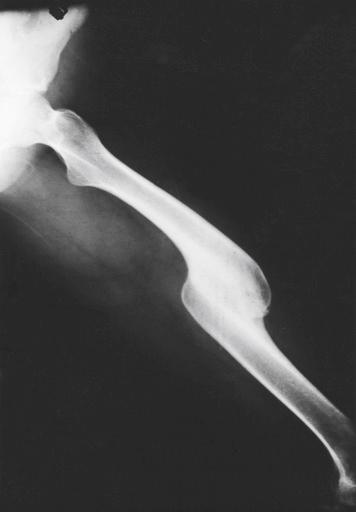
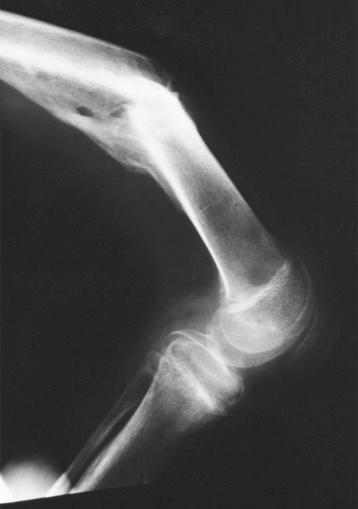
Cross union is a rare and serious complication of fractures of the forearm. Rotation of the forearm is impossible and may lead to a serious compromise in function. Cross union must be distinguished from myositis ossificans, which is more common and typically less disabling. Most cross unions are confined to the proximal third of the radius and ulna. Most authors recommend that if open reduction of forearm fractures is required, the surgery be performed through two incisions; however, this technique does not necessarily prevent cross union. Similarly, synostosis has been reported after intramedullary fixation of fractures. Other predisposing factors include severe initial displacement, fracture comminution, residual displacement, periosteal interposition, delayed surgery, remanipulation, and fracture at the same level of the radius and ulna.
Early studies of management of synostosis recommended delaying surgical intervention for 1 to 2 years after onset for best results. However, surgical intervention has been demonstrated to be safe if there is radiographic evidence consistent with maturation of the synostosis, such as a well-marginated edge and no evidence of bridging trabeculae. A bone scan may be useful for establishing that the healing reaction is complete and that isotope uptake has returned to the same level as that in the surrounding bone, consistent with a mature synostosis. When a synostosis is excised, it is important that the bone bridge and its periosteum be removed intact to lessen the chance of recurrence. Several authors suggest interposing fat, muscle, or silicone elastomer (Silastic) between the radius and ulna to prevent recurrence; however, only a few patients had a recurrence, and follow-up data are limited. If surgery is delayed too long, soft tissue contractures may preclude recovery of maximal range of pronation and supination ( Fig. 7.10 ).
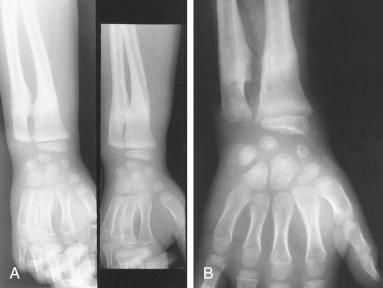
The same problem can develop between the tibia and the fibula. Tibial-fibular synostosis is associated with high-energy trauma that results in displaced fractures of the distal tibia and fibula at the same level. In a child, this may lead to disproportionate growth. One should allow 3 months to 1 year for the synostosis to mature before excision. A similar surgical recommendation could be considered to keep the fibula moving freely at the ankle joint. Another alternative is resection of a portion of the fibula and screw fixation of the distal end of the fibula to the tibial epiphysis.
Nonunion of fractures is rare in children ( Fig. 7.11 ). In two large series from the Mayo Clinic, the tibia was the most common diaphyseal region involved, and fractures about the elbow accounted for the largest number of metaphyseal and epiphyseal nonunions. Generally, nonunion is associated with high-energy trauma and open fractures with extensive soft tissue disruption and infection. A recent retrospective review of adolescents who sustained diaphyseal fracture nonunions found that soft tissue injury, older patient age, and insufficient fracture fixation were the strongest predictors for nonunion. These findings have been supported by multiple studies. Open reduction and internal fixation may contribute if the fixation is inadequate or holds the fracture fragments apart. Nonunion is more likely in an older child who is approaching maturation. An open fracture in children older than 11 or 12 years significantly increases the risk of nonunion when compared with the same injury in children younger than 6 years. Perioperative use of ketorolac has not been associated with an increased risk of nonunion.
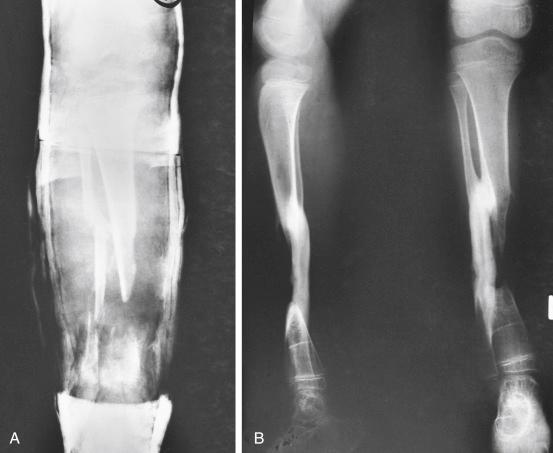
The same treatment techniques for nonunion that have been successful in adults can be used in children. The endosteal response can be improved if the dense fibrous tissue and subchondral bone is resected so that the marrow spaces are communicating. Internal fixation and autogenous bone graft are recommended. Intramedullary fixation may be preferable for an unstable fracture. Fixation plates provide more rigid fixation, but great care should be exercised to minimize dissection that may further compromise blood flow to the bone. An Ilizarov fixator may improve results in the lower extremities, in addition to treating pseudarthrosis, and the discrepancy in length or angulation can be corrected at the same time.
Fractures of the femoral neck are associated with a high incidence of nonunion because of failure to achieve and maintain adequate initial anatomic reduction. Similarly, loss of reduction can occur because of failure of fixation such as from screw breakage. These fractures are usually transcervical and may be associated with avascular necrosis. In Morsy’s group of 53 children, 36% developed nonunion, the majority of whom had transcervical fractures. Only 2 (8%) of the 26 patients who had anatomic reductions developed a nonunion compared with 9 (64%) of the 14 patients whose fractures were not anatomically reduced. A systematic review of femoral neck fracture outcomes also found that transcervical fractures posed the greatest risk for nonunion, but the authors cited a slightly lower nonunion incidence of 17.4%.
Nonunion of a displaced fracture of the lateral humeral condyle ( Fig. 7.12 ) is a common problem. Among 530 patients treated with lateral condyle fractures, Pace et al reported a 1.4% rate of fracture nonunion with fractures displaced more than 2 mm at the cartilaginous surface at the time of injury having a nonunion rate as high as 3%. Such fractures must be watched closely for displacement if nonoperative treatment is elected. If the fracture becomes displaced, it has a great propensity for nonunion because the fracture surface of the condyle rotates away from the metaphysis. Flynn recommends that when the distance is 2 mm or greater, these fractures should be surgically reduced and pinned to prevent further displacement and possible nonunion.
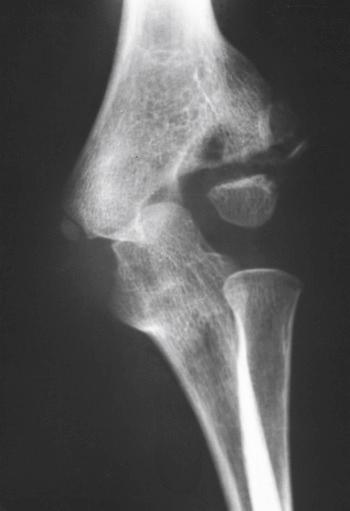
Early recognition of nonunion should be treated by early stabilization and bone grafting if the fragment is in an acceptable position and the growth plate of the condyle is open. Procrastination may allow the physis of the condylar fragment to close prematurely, and a golden opportunity to salvage the elbow would be lost. If the fragment is not rotated or displaced too much, either in situ screw fixation or removal of the fibrous tissue and bone grafting usually suffice. Greater displacement requires reattachment of the fragment with a screw or threaded pin; however, some loss of elbow motion may occur. Every effort should be made to avoid further stripping of soft tissue to prevent avascular necrosis of the fragment. In late cases in which anatomic reduction is not possible, the fragment is stabilized in the position that yields the greatest range of motion (i.e., functional reduction). If necessary, supracondylar osteotomy can be performed to restore alignment.
A carpal scaphoid nonunion typically occurs in adolescents in whom the injury was originally unrecognized. If the fracture is initially treated by cast immobilization, nonunion is rare. Treatment of the nonunion is similar to that in an adult.
Become a Clinical Tree membership for Full access and enjoy Unlimited articles
If you are a member. Log in here